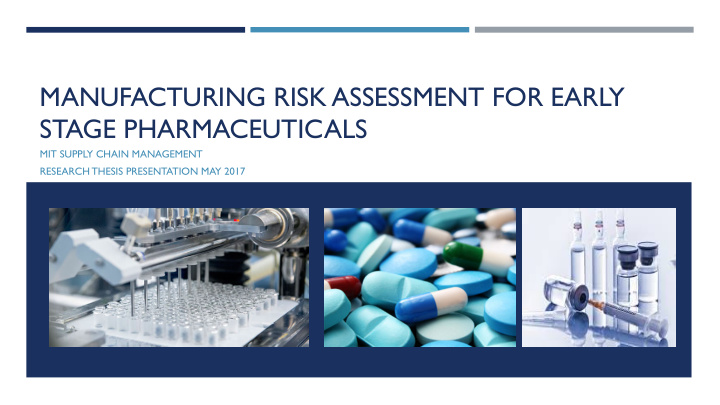



MANUFACTURING RISK ASSESSMENT FOR EARLY STAGE PHARMACEUTICALS MIT SUPPLY CHAIN MANAGEMENT RESEARCH THESIS PRESENTATION MAY 2017
THESIS WRITERS AND CONTRIBUTORS Emily Chen, Author MIT Masters of Engineering in Supply Chain Management candidate 2017 Former Program Manager, Supply Chain Optimization Technologies at Amazon BA Economics, University of Chicago Ozgu Turgut, Thesis Advisor Postdoctoral Associate, MIT Center for Transportation and Logistics Former Research Scientist at Llamasoft BS, Bosporus University MSc., Yeditepe University PhD, Industrial and Systems Engineering, Wayne State University
THESIS OVERVIEW Objective Develop a method to assess potential manufacturing risk for early stage (pre-phase III) pharmaceuticals that can be used for molecules in the drug development pipeline Motivation To meet future patient demand for drugs in development now, manufacturing decisions often need to be made during the early stages of the drug development process where a high degree of uncertainty exists Approach Using a Discrete Event Simulation model, manufacturing risk was assessed for an individual molecule to assess maxed-capacity, under-utilization, and over-utilization scenarios based on given capacity Conclusion Manufacturing capacity risk for early stage molecules can be simulated through a flexible and adaptable model. With accurate inputs provided, results can influence management decisions on future capacity resources
BACKGROUND AND MOTIVATION The drug development process is long, risky, and expensive It costs $1.4B on average to develop a new drug (Tufts CSDD)
BACKGROUND AND MOTIVATION Drug manufacturing is complicated and highly regulated ¡ FDA quality control measures – CGMP (Current Good Manufacturing Processes) ¡ Many decision variables involved in capacity expansion or modification ¡ Long timelines: 7-10 years to open a new site ¡ Out of stock implications
MOTIVATION AND THE MODEL The drug development process is long, risky, and expensive & Drug manufacturing is complicated and highly regulated Model needs to be adaptable and flexible
THE MODEL Discrete Event Simulation (DES) ¡ Many stochastic parameters ¡ Differentiation and novelty to existing method ¡ Linearity of decisions and events Source: Memorial University Computer Science
THE MODEL Stochastic parameter inputs Active New product Packaging, pharmaceutical development & storage and ingredient (API) innovation distribution manufacturing ¡ Patient compliance ¡ Patient population ¡ Dosage ¡ Market share ¡ Treatment duration
THE MODEL Desired model outputs Generated by model Anticipated API quantities projected versus Provided by sponsoring company Planned network manufacturing capacity = Assessment of manufacturing capacity risk (over, under, or target utilization)
MODEL STRUCTURE IN ARENA SIMULATION SOFTWARE
MODEL STRUCTURE SIMPLIFIED Apply variable factors: Assign possible Calculate annual Initial eligible efficacy dosages and estimated API patient population compliance duration demand in kg market share Assign API demand to Using targeted, minimum, and maximum planned capacity utilization targets specified for each eligible site, at sites then assign a risk rating for the network
THE MODEL Manufacturing risk assessment scenarios ¡ None : Demand is satisfied by at least target allocation to all available sites ¡ Low : Demand is satisfied while running some sites at under minimum capacity ¡ Medium : Demand is satisfied while running some sites at maximum capacity ¡ High : Demand is not satisfied while running all sites at maximum capacity
ADDITIONAL ANALYSIS OF OUTPUTS Overall Anticipated API Output Year over Year 1,400 1,200 API units (kg) 1,000 800 600 400 200 - 1 2 3 4 5 6 7 Year Conf Interval Low Conf Interval High 1. Is there enough capacity to handle anticipated demand? 2. Are there parameters that influence risk more than others?
CONCLUSION Biopharmaceutical companies make big bets with limited information to plan for manufacturing of drugs in early stages of development ¡ The model serves a purpose . Making safer bets to meet patient needs. ¡ The model is a framework . Adaptable, flexible, customizable. ¡ The model has limitations . There is no “one model fits all”.
THANK YOU
Recommend
More recommend